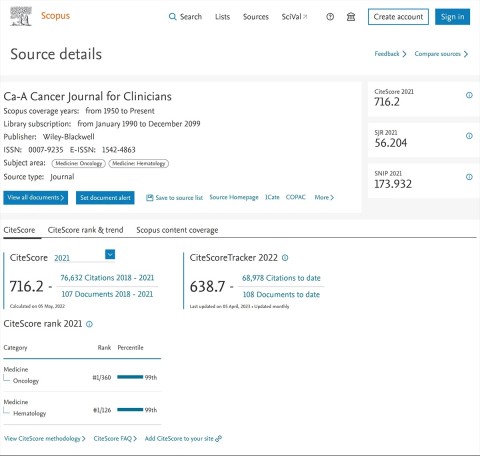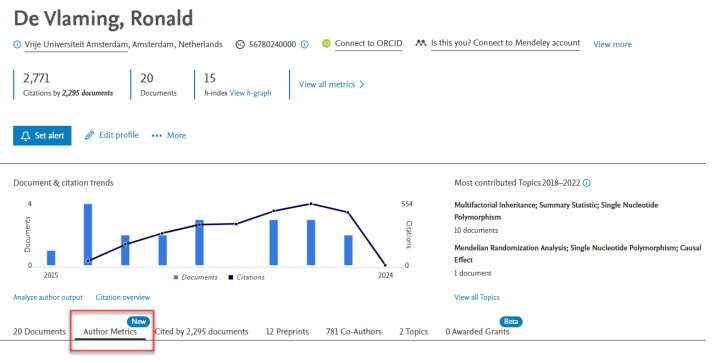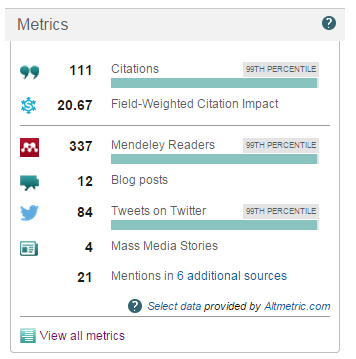Scopus-indexed journals are academic and peer-reviewed journals included in the Scopus database, one of the largest and most comprehensive abstract and citation databases of peer-reviewed literature. These journals are indexed based on strict criteria, ensuring they meet high quality standards, credibility and academic rigour. Being indexed in Scopus means that a journal’s articles are accessible to a global academic audience and are recognised for their scholarly impact. The inclusion in Scopus also helps researchers track citations, measure impact and access a wide range of scientific information.
Since Scopus-indexed journals play a significant role in the academic and scientific community, understanding the metrics, submission guidelines and key considerations associated with them is vital for researchers looking to publish their work effectively. Read this post to understand the essential aspects of Scopus-indexed journals and better understand their impact and importance in the research community.
- Scopus metrics
- How to find Scopus-indexed journals
- Highest-ranking Scopus-indexed journals
- Before submitting an article
- Benefits
- Drawbacks
- Costs
- Using professional editing services
Scopus metrics
Scopus metrics are categorised into various groups that help assess the impact and quality of journals, authors and institutions. Here are the key Scopus metrics, organised by category:
Journal metrics
- CiteScore measures the average citations received per document published in a journal within a specific period.
- CiteScore Percentile provides a relative standing of a journal within its subject field.
- Source Normalised Impact per Paper (SNIP) measures contextual citation impact by normalising differences in citation practices across disciplines.
- SCImago Journal Rank (SJR) evaluates journal impact based on both the quantity and quality of citations, considering the prestige of citing journals.
- H-Index reflects both the productivity and citation impact of the publications of a journal.
- Journal Citation Count is the total number of citations received by all documents published in the journal.
- Percentage Cited measures the proportion of documents published in a journal that have received at least one citation.
- Field-Weighted Citation Impact (FWCI) compares the actual number of citations received by a journal’s articles to the expected number of citations for similar articles in the same field.
- Journal Self-Citations tracks the proportion of citations in the journal that come from articles within the same journal.
- Scholarly Output measures the total number of documents published in the journal within a specific period.

Author metrics
- H-Index measures both the productivity and citation impact of the publications of an author.
- Citation Count is the total number of citations received by an author’s publications.
- Documents in Scopus is the total number of documents authored or co-authored by a researcher indexed in Scopus.
- Author Citation Impact: includes metrics like total citations, citations per document and field-weighted citation impact specific to the author.

Institution metrics
- Institutional H-Index measures both the productivity and citation impact of the publications associated with an institution.
- Institutional Citation Count is the total number of citations received by publications from an institution.
- Scholarly Output measures the total number of documents published by an institution within a specific period.
- Field-Weighted Citation Impact compares the actual number of citations received by an institution’s articles to the expected number of citations for similar articles in the same field.
- Collaboration metrics measure the degree of international, national and institutional collaboration on publications.
Article-level metrics
- Citation Count is the number of times a specific article has been cited by other documents.
- Field-Weighted Citation Impact compares the actual number of citations received by an article to the expected number of citations for similar articles in the same field.
- Views and Downloads usage metrics indicate how often an article has been viewed or downloaded.
Usage metrics
- Views are the number of times articles have been viewed on the platform.
- Downloads are the number of times articles have been downloaded.
Altmetrics
- Altmetric Attention Score tracks online attention and engagement an article receives on platforms like social media, news outlets, policy documents, etc.

How to find Scopus-indexed journals?
Here are some databases where you can find Scopus-indexed academic journals:
- Clarivate (Web of Science) includes journals indexed by Scopus and provides citation reports.
- Google Scholar can be used to locate articles in Scopus-indexed journals.
- IEEE Xplore focuses on engineering and technology journals indexed by Scopus.
- JSTOR: Includes a range of academic journals, some indexed in Scopus.
- ProQuest offers access to academic journals, many indexed by Scopus.
- PubMed: For biomedical and life sciences journals, many of which are also indexed in Scopus.
- ScienceDirect: Elsevier’s full-text scientific database containing many Scopus-indexed journals.
- Scopus: The primary database itself, offering a comprehensive list of indexed journals.
- SpringerLink provides access to many journals indexed in Scopus.
- Wiley Online Library hosts numerous Scopus-indexed journals across various disciplines.
Using these databases, you can find Scopus-indexed journals across different academic disciplines.
What are the highest-ranking Scopus-indexed journals?
Here are some examples of top-ranking Scopus-indexed journals in 5 disciplines, along with their approximate impact factors or ranking scores (based on 2022 and 2023 data):
Medicine
- BMJ (British Medical Journal) —Impact factor: 93.6 — First published in 1840, BMJ is a leading international peer-reviewed medical journal that publishes original research, reviews and editorial opinions.
- JAMA(Journal of the American Medical Association) — Impact factor: 63.1 — Founded in 1883, JAMA publishes original research, reviews and editorials covering all aspects of clinical medicine and public health.
- Nature Medicine — Impact factor: 58.7 — Launched in 1995, this journal publishes original research articles in all areas of medicine with a strong emphasis on novel and impactful discoveries.
- The Lancet — Impact factor: 98.4 — Founded in 1823, The Lancet is a leading general medical journal known for its high-impact original research, reviews and editorials in various medical fields.
- The New England Journal of Medicine (NEJM) — Impact factor: 91.2 — Established in 1812, NEJM is one of the most prestigious medical journals, publishing cutting-edge research, reviews and commentary on various medical topics.
Engineering
- Advanced Materials — Impact factor: 25.8 — Launched in 1989, it is one of the top journals for materials science, covering a broad range of topics including nanotechnology, biomaterials and electronic materials.
- Energy & Environmental Science — Impact factor — 32.4 — Established in 2008, this journal publishes research on sustainable energy and environmental science, emphasising renewable energy sources and environmental impact.
- IEEE Transactions on Pattern Analysis and Machine Intelligence (IEEE TPAMI) — Impact factor: 20.8 — Established in 1979, IEEE TPAMI publishes research on all aspects of pattern analysis and machine intelligence, including computer vision and artificial intelligence.
- Nature Nanotechnology — Impact factor: 38.1 — Since its launch in 2006, this journal has been at the forefront of nanotechnology research, publishing high-impact studies on nanoscale materials and devices.
- Progress in Energy and Combustion Science (PECS) — Impact factor: 59.3 — Since 1975, PECS has provided in-depth reviews of recent energy and combustion research advances.
Life sciences
- Cell — Impact factor: 66.8 — Founded in 1974, Cell is a leading journal that publishes high-impact research across all areas of life sciences.
- Nature Biotechnology — Impact factor: 56.9 — Established in 1996, this journal publishes high-impact research in biotechnology, including medical and agricultural applications.
- Nature Reviews Genetics — Impact factor: 52. 3 — Since 2000, this journal has provided in-depth reviews on all aspects of genetics and genomics.
- Nature Reviews Immunology — Impact factor: 78.1 — Launched in 2001, it covers the most significant developments in the field of immunology.
- Nature Reviews Molecular Cell Biology — Impact factor: 113.9 — Since 2000, this journal has published comprehensive and authoritative molecular and cell biology reviews.
What to consider when submitting an article to a Scopus-indexed journal?
When submitting an article to a Scopus-indexed journal, several important factors to consider to ensure the success and impact of your submission. Here are key considerations:
Journal selection
- Relevance: Choose a journal that aligns well with your research topic and field. Ensure the scope and aim of the journal match the content of your article.
- Impact factor and metrics: Consider the journal’s impact factor, CiteScore, SNIP and SJR to assess its influence and reputation.
- Audience: Ensure the journal’s audience is appropriate for your research. The journal should reach the researchers and practitioners who will benefit most from your work.
Submission guidelines
- Manuscript formatting: Adhere strictly to the journal’s formatting requirements for manuscript preparation, including structure, citation style and length.
- Submission process: Familiarise yourself with the submission process, including any online submission systems and required forms or declarations.
Quality and originality
- Novelty: Ensure your research presents original findings, insights or methodologies that advance the field.
- Significance: Highlight the significance and implications of your research. Explain how it contributes to existing knowledge or addresses gaps in the literature.
Peer review process
- Peer review: Understand that Scopus-indexed journals typically undergo a rigorous peer review process. Be prepared for potential revisions and constructive feedback from reviewers.
Ethical considerations
- Ethical approval: Ensure your research has received all necessary ethical approvals, especially if it involves human or animal subjects.
- Conflict of interest: Declare any potential conflicts of interest. Transparency is crucial for maintaining trust in the research process.
- Plagiarism: Use plagiarism detection software to ensure your work is original and properly cites all sources. Plagiarism can lead to rejection and damage your reputation.
Reference management
- Citation style: Format your references according to the journal’s required citation style.
- Recent and relevant: Include recent and relevant references to situate your research within the current literature.
Author contributions
- Authorship criteria: Ensure all listed authors meet the criteria for authorship and have contributed significantly to the research.
- Corresponding author: Designate a corresponding author who will handle communications with the journal during the submission and review process.
Open access options
- Open access: Consider whether you want to publish your article as open access, which may increase its visibility and impact. Be aware of any associated publication fees.
Journal policies
- Preprint policy: Check the journal’s policy on preprints if you have already posted your work on a preprint server.
- Publication charges: Be aware of any publication charges or fees associated with the journal.
Timeliness
- Response time: Consider the journal’s average review and publication times. Timely publication is important for disseminating your findings.
Language and writing quality
- Clarity: Ensure your manuscript is clear, free of jargon and accessible to readers in your field.
- Proofreading: Proofread your manuscript for grammar, punctuation and spelling errors. Consider professional editing services if necessary.
What are the benefits of publishing an article in a Scopus-indexed journal?
Publishing an article in a Scopus-indexed journal offers numerous benefits that can significantly enhance a researcher’s academic and professional career. Here are some of the key advantages:
Increased visibility and accessibility
Scopus is a widely used database accessed by researchers, academic institutions and libraries worldwide, ensuring that your work reaches a broad audience. Moreover, articles in Scopus-indexed journals are easily searchable, increasing the likelihood that other researchers will find and cite your work.
Enhanced credibility and reputation
Scopus-indexed journals are subject to rigorous peer-review and selection criteria, which helps ensure high academic standards and credibility. In addition, publishing in reputable journals may enhance your professional standing and can lead to greater recognition in your field.
Impact and citations
Articles in Scopus-indexed journals are tracked for citations, which can contribute to higher citation counts and impact factors, reflecting the influence of your research. High citation counts can indicate the relevance and importance of your work to the academic community, potentially influencing future research.
Career advancement
Publications in high-quality journals can be a criterion for hiring, tenure and promotion decisions in academia. In addition, having a strong publication record in Scopus-indexed journals can improve your chances of securing research grants and funding.
Networking and collaboration
Your research being accessible to a wide audience can lead to new collaborations and networking opportunities with other researchers in your field. Furthermore, high-impact publications can lead to invitations to speak at conferences, seminars and workshops, further enhancing your professional profile.
Academic contribution and recognition
Publishing in Scopus-indexed journals allows you to contribute to the body of knowledge in your field, advancing research and scholarship. Also, being published in prestigious journals often brings recognition from peers and can lead to awards and honours. Finally, your publication can contribute to your institution’s research output and rankings, benefiting both you and your institution.
Quality of peer review
Scopus-indexed journals apply thorough and rigorous peer-review processes, which can improve the quality of your manuscript through constructive feedback.
Long-term accessibility and archiving
Scopus-indexed journals archive articles, which remain accessible long-term, ensuring that your research has lasting visibility and impact. Moreover, publications in these journals typically receive a digital object identifier (DOI), which provides a permanent link to your work.
What are the drawbacks of publishing an article in a Scopus-indexed journal?
While publishing in Scopus-indexed journals offers many benefits, there are also some drawbacks to consider:
High competition and rejection rates
Scopus-indexed journals often have high standards and rigorous peer-review processes, leading to high rejection rates. Moreover, due to their prestige, these journals attract numerous submissions, affecting low acceptance rates (vs high submission rates).
Lengthy review and publication process
The peer-review process can be lengthy, sometimes taking several months to over a year. And even after acceptance, significant delays may affect the publication timeline.
Publication fees
Many Scopus-indexed journals charge substantial fees for open access publication, which can be a financial burden. Furthermore, some journals also have submission fees, adding to the cost.
Limited scope
Some Scopus-indexed journals have a very specific focus, which may not align perfectly with all research topics, limiting the options for publication. Likewise, certain fields may have fewer Scopus-indexed journals, making it harder for researchers in those areas to publish.
Pressure and stress
The pressure to publish in prestigious journals can be stressful, particularly for early-career researchers. Furthermore, the stress associated with the high standards and potential rejections can negatively impact mental health.
Potential for predatory journals
Some journals may falsely claim to be Scopus-indexed to attract submissions and fees. Researchers need to verify the legitimacy of the journal.
Intellectual property concerns
Publishing in some journals may require authors to transfer copyright, potentially limiting the ability to share their work freely.
Focus on metrics
Emphasis on citation metrics can lead to a focus on quantity over quality, encouraging the publication of less innovative work. On the other hand, some researchers might engage in practices like excessive self-citation to boost metrics, which can distort the true impact of research.
Language barriers
Researchers with English as their second language may face challenges in meeting the language standards required by many Scopus-indexed journals.
What are the costs associated with publishing in the Scopus-indexed journals?
When considering submitting an article to a Scopus-indexed journal, it is important to be aware of the associated costs, particularly if you are opting for open access. Here are some insights on the average costs:
Open access fees
- MDPI charges article processing charges (APCs) that typically range from CHF 1,000 to CHF 2,900, depending on the journal. For example, journals like Antibiotics charge CHF 2,900, while others like Adolescents charge CHF 1,000.
- APCs for Springer Nature journals vary widely. For instance, open-access fees for journals such as Nature Communications and Scientific Reports are around $5,000–$6,300 per article.
- PLOS ONE charges $2,290 for most research articles. Other specialised PLOS journals like PLOS Medicine charge up to $6,300 for a research article. PLOS also offers fee assistance for researchers unable to pay all or part of their publication fees and who can demonstrate financial need (called the PLOS Publication Fee Assistance).
- Wolters Kluwer (Lippincott Journals) fees range from $650 for case reports to $3,000 for original research articles in certain journals. For example, PAIN Reports charges $3,000 for original research articles.
Submission fees
While many journals do not charge submission fees, some may have them, particularly if they offer a fast-track review process or additional services. Always check the specific journal’s guidelines for submission fees.
For instance, Taylor & Francis offers an Accelerated Publication option for several of their journals, which expedites the publication process to as fast as 3–5 weeks from submission. This service costs $7,000 for the fastest option and $3,900 for a slightly slower expedited process. This option ensures quicker peer review and publication timelines but comes at a premium cost.
How can professional editing services prepare an article for submission to a Scopus-indexed journal?
Using different types of editing services can greatly enhance the quality and readiness of your article for submission to a Scopus-indexed journal. Each service targets specific aspects of your manuscript, ensuring it meets high academic standards and the journal’s requirements. Here’s how each type of editing service can help:
Proofreading
Proofreading focuses on correcting surface errors in text, such as grammar, punctuation, spelling and formatting issues. It ensures that your manuscript is free from minor errors that could distract reviewers or undermine the professionalism of your work. It is the final polish before submission. Proofreading provides a final check to catch any lingering errors after the main editing phases, ensuring your manuscript is error-free. Moreover, it ensures that the manuscript complies with the journal’s specific formatting guidelines.
Copyediting
Copyediting involves a thorough review of the text to correct grammar, punctuation, syntax and usage errors. It also ensures consistency in style and tone. It enhances the readability and coherence of your manuscript, ensuring it adheres to the journal’s style guide. Moreover, copyediting ensures consistency in terminology, notation and overall style, making your manuscript clear and professional. In addition, it checks for correct and consistent use of citations and references according to the journal’s guidelines. In sum, copyediting improves the overall clarity and flow of the text.
Line editing
Line editing focuses on the content, style and language of each line. It looks at word choice, sentence structure and the overall effectiveness of the language used. This service improves the readability and impact of your writing by refining sentence structure, eliminating redundancy and enhancing clarity and style. This makes your arguments more compelling and easier to follow. Moreover, line editing refines the language to improve readability and engagement, making complex ideas more accessible. Finally, line editing elevates the writing style to meet the high standards expected by peer reviewers and journal editors.
Developmental editing
Developmental editing addresses the big picture of your manuscript. It involves evaluating the structure, organisation and content of the document to ensure that it effectively communicates your research. This service helps to strengthen your manuscript’s overall structure and coherence, ensuring logical presentation and sound support of your argument. It is particularly useful for addressing any gaps in the research, enhancing the flow and ensuring that the manuscript meets the journal’s standards. In sum, developmental editing ensures your manuscript has a strong, logical structure with clear, well-supported arguments.
Translation editing
Translation editing is essential for manuscripts translated from another language. It involves ensuring that the translation is accurate, culturally appropriate and maintains the original meaning. It ensures that your translated manuscript reads naturally in the target language, adheres to academic standards and accurately reflects the original research. Translation editing ensures the translated manuscript accurately conveys the original meaning and is fluent and natural in the target language. Moreover, it adapts cultural references and idiomatic expressions to be appropriate for the target audience. This service is particularly helpful for multilingual authors for whom English is the second language when submitting to an English-language journal or for authors who are submitting translated research articles.
Key takeaways
Scopus-indexed journals play a significant role in the academic and scientific community, ensuring high-quality standards, credibility and academic rigour. The associated metrics help assess the impact and quality of journals, authors and institutions. When submitting an article to a Scopus-indexed journal, it is vital to consider the relevance of the journal to your research, its impact factor and metrics and the target audience and scope.
Benefits of publishing in Scopus-indexed journals include increased visibility, credibility and accessibility of your research to a global audience. Additionally, Scopus metrics provide a quantitative measure of the impact and reach of published work. However, it is essential to consider the potential drawbacks and costs associated with publishing in Scopus-indexed journals. These may include high publication fees, long publication process and low acceptance rates.
I am an editor and indexer working with academic writers, journals and presses. If your academic manuscript needs a second pair of eyes, contact me for a free sample edit (and remember to use my early bird discount).

